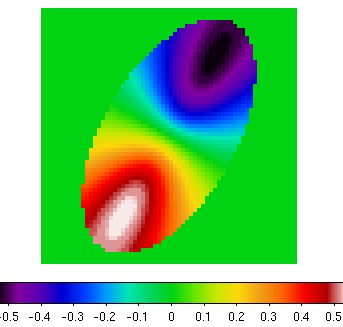Here are some examples of how to generate some galactic velocity fields within NEMO, and analyze them. There are several ways to get a velocity field: from snapshots, from orbits (but turning them into a snapshot to make the velocity field) and directly from observations (usually via a FITS file). In addition, RA-DEC-VEL style datacubes can also be generated (or read) from which velocity fields can then be derived.
The first step is create a rotating thin disk, and incline it a bit:
% mkspiral - 200000 rmax=2 a=0 | snaprotate - snap1 60,60 xzwhich is a snapshot. There are several ways to make a velocity field out of this:
% snapmap snap1 map1 % ds9 & % nds9 map1

% snapgrid snap1 map2 moment=-1 % ccdmath map1,map2 map1-2 %1-%2gives nearly the same result, as can be seen by viewing a difference map.
Third, create a cube:
% snapgrid snap1 cube1 zrange=-0.6:0.6 nz=64 % ccdmom cube1 map3 axis=3 mom=1 % ccdmath map1,map3 map1-3 %1-%2 % ccdstat map3 bad=0 Min=-0.515625 Max=0.516481 Number of points : 1701 Mean and dispersion : 0.000112 0.027680 Skewness and kurtosis : 3.350128 274.874773 Sum and Sum*Dx*Dy*Dz : 0.190883 0.000746 2395/4096 out-of-range points discarded
Lastly, pvtrace can now also be used on cubes:
% pvtrace cube1 out=map4 mode=3 ### Warning [pvtrace]: cube mode ### nemo Debug Info: Map [64 x 64 POS x 64 VEL] I_t=0.040192 vsys=0 (vrange: -0.590625 0.590625) ### nemo Debug Info: MinMax in map: -0.534375 0.534375 % ccdmath map1,map4 map1-4 %1-%2 % ccdstat map4 bad=0 Min=-0.515625 Max=0.516481 Number of points : 1701 Mean and dispersion : 0.000112 0.027680 Skewness and kurtosis : 3.350128 274.874773 Sum and Sum*Dx*Dy*Dz : 0.190883 0.000746 2395/4096 out-of-range points discarded
This page was last modified on 17-Aug-2009 by PJT.